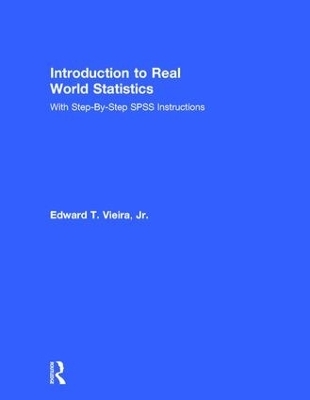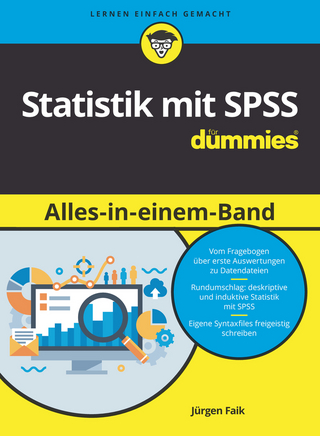
Introduction to Real World Statistics
Routledge (Verlag)
978-1-138-29231-4 (ISBN)
- Titel z.Zt. nicht lieferbar
- Versandkostenfrei innerhalb Deutschlands
- Auch auf Rechnung
- Verfügbarkeit in der Filiale vor Ort prüfen
- Artikel merken
Notable features include:
short, digestible chapters that build and integrate statistical skills with real-world applications, demonstrating the flexible usage of statistics for evidence-based decision-making
statistical procedures presented in a practical context with less emphasis on technical jargon
early chapters that build a foundation before presenting statistical procedures
SPSS step-by-step detailed instructions designed to reinforce student understanding
real world exercises complete with answers
chapter PowerPoints and test banks for instructors.
Edward T. Vieira, Jr. is an Associate Professor, Research Director, and member of the Institutional Review Board at Simmons College, Boston, Massachusetts, USA. He earned his M.B.A from Bryant University and Ph.D. from the University of Connecticut. Currently, Dr. Vieira serves on the editorial boards of seven peer-reviewed journals providing statistical and methodological expertise. He has over 30 years of management, research, and consulting experience in areas such as marketing research, community outreach focus groups, organizational research, and education evaluation research.
Preface
Why Read This Book?
Notable Features
Assumes No Prior Knowledge of Statistics
Short Digestible Chapters That Build and Integrate Real World Statistical Skills
An Alternative to the Traditional Hypothesis Testing Approach
Interdisciplinary Applications
SPSS Step-by-Step Detailed Instructions with Screenshots
Chapter PowerPoints and Test Bank
A Systematic Approach to Teaching Statistics
Book Organization
Acknowledgments
PART I: GETTING STARTED
1 Introduction to Real World Statistics
Learning Objectives
1.1 What Is Statistics?
Sample Data vs. Census Data
1.2 Reification
1.3 Naïve Science: The Deception of Common Sense
Real World Snapshot
1.4 Importance of Statistics
Statistical Assumptions
Summary of Key Concepts
Introductory Applied Exercises
2 Statistics: Descriptive, Correlation, and Inferential
Learning Objectives
2.1 Introduction to Descriptive, Correlation, and Inferential Statistics
2.2 Descriptive Statistics
Measures of Variation
2.3 Correlation Statistics
2.4 Inferential Statistics
Real World Snapshot
2.5 Descriptive, Correlation, and Inferential Statistics
Summary of Key Concepts
Descriptive, Correlation, and Inferential Statistics Applied Exercises
3 Data and Types of Variables
Learning Objectives
3.1 Introduction to Variables
3.2 Kinds of Variables
3.3 Variables by Type of Data
Categorical Data
Binary-Level Data (Variable)
Nominal-Level Data (Variable)
Ordinal-Level Data (Variable)
Numeric Data
Ratio-Level Data (Variable)
Interval-Level Data (Variable)
Scale Response Formatted Variables: A Special Case
Appropriate Analysis for Variable (Data) Type
Real World Snapshot
3.4 Variables by Influence
Independent Variables (Predictors)
Dependent Variables (Outcomes)
Control Variables
Interaction Variables
Summary of Key Concepts
Variables Applied Exercises
4 SPSS Statistics Data Management Basics: Preparing Data for Analysis
Learning Objectives
4.1 Introduction to SPSS and Data, Output, and Syntax Files
4.2 Setting up the Data File
4.3 Key SPSS Data Management Tools
4.4 Opening SPSS
4.5 Formatting the Variables’ Data
Name
Type
Width
Decimals
Label
Values
Missing
Column
Align
Measure
Role
4.6 The SPSS Data File
Data Access
Manual Entry
Opening an Existing SPSS Data File
Opening Other Formatted Spreadsheet Data Files
Text Files
Cut and Paste
Saving the Data File
Saving Data in SPSS
Saving Data in Other Spreadsheet Formats
4.7 The SPSS Output File
Creating a New SPSS Output File
Opening an Existing SPSS Output File
Displaying the Full P-Value in the Output File
Saving an SPSS Output File
Saving Output for the SPSS Output Viewer
Saving SPSS Output in Another Format
4.8 A Brief Review of the Syntax File
4.9 Creating a Codebook
Creating a Codebook from Scratch
Real World Snapshot
The SPSS Codebook
Summary of Key Concepts
Data Management Applied Exercises
PART II: SAMPLING CONSIDERATIONS
5 Sampling Strategies
Learning Objectives
5.1 Introduction to the Sampling Process
5.2 Probability Sampling
Random vs. Representative Sampling
Random Sampling and the Shape of Data Distribution
Simple Random Sampling
Systematic Random Sampling
Cluster (Random) Sampling
Stratified Random Sampling
Real World Snapshot
5.3 Nonprobability Sampling
Convenience Sampling
Expert Sampling
Quota Sampling
Snowball Sampling
Summary of Key Concepts
Sampling Applied Exercises
6 Sample Size
Learning Objectives
6.1 Introduction to Sample Size
Numeric Data
Central Limit Theorem
Categorical Data
Other Considerations
6.2 Power Analysis and Sample Size
Finite Population Correction
Informed Power Analysis
Real World Snapshot
Comparison of Unequal Sample Sizes
Data Assumptions
6.3 Examples Using SPSS: Step-by-Step Instructions
Example 6.1: Means: One-sample t-test that mean = specific value
Interpretation
Example 6.2: Means: Paired t-test that mean = 0
Interpretation
Example 6.3: Proportions: One-sample test that proportion = ".50"
Interpretation
Example 6.4: Proportions: 2 × 2 for independent samples (chi-square or Fisher’s exact test)
Interpretation
Example 6.5: Correlations: One-sample test that correlation = 0
Interpretation
Example 6.6: ANOVA: One-way analysis of variance
Interpretation
Example 6.7: Regression: One set of predictors
Interpretation
Example 6.8: Clustering
Interpretation
Summary of Key Concepts
Sample Size Applied Exercises
7 Sources and Types of Statistical Error
Learning Objectives
7.1 Introduction to Sources of Statistical Error
Real World Snapshot
7.2 Sampling Error
Sampling Random Error
Sampling Systematic Error
7.3 Nonsampling Error
Nonsampling Random Error
Nonsampling Systematic Error
Summary of Key Concepts
Statistical Error Applied Exercises
8 Missing Data
Learning Objectives
8.1 Introduction to Missing Data
8.2 Missing Value (Data) Analysis
Real World Snapshot
8.3 Methods for Replacing Missing Values
Listwise (Casewise)
Pairwise
Series Mean
Mean of Nearby Points
Median of Nearby Points
Linear Interpolation
Linear Trend at Point
8.4 New Data Replacement Methods
Expectation Maximization
Multiple Imputation
8.5 Examples Using SPSS: Step-by-Step Instructions
Example 8.1: The MCAR Case
Interpretation
Write-Up
Example 8.2: The NMAR Case
Interpretation
Write-Up
Summary of Key Concepts
Missing Data Applied Exercises
PART III: DATA SCREENING, DESCRIBING, AND PROBABILITIES
9 Describing Categorical Variables
Learning Objectives
9.1 Introduction to Describing Categorical Variables
Real World Snapshot
9.2 Charting Categorical Variables
Pie Chart
Dichotomous (Two-Category) Pie Chart
Example 9.1: A Pie Chart with Two Categories
Describing and Reporting
Multiple Category Pie Chart
Example 9.2: A Pie Chart with More Than Two Categories
Describing and Reporting
Bar Chart
Example 9.3: A Bar Chart with More Than Two Categories
Describing and Reporting
9.3 Categorical Variable Tables
Single Variable Tables
Example 9.4: A Single Categorical Variable with Two Categories Table
Describing and Reporting
Example 9.5: A Single Categorical Variable with More Than Two Categories Table
Describing and Reporting
Multiple Variable Tables
Two Variables
Example 9.6: Two Categorical Variables Each with Two or More Categories Table
Describing and Reporting
Three Variables
Example 9.7: Three Categorical Variables Each with Two or More Categories Table
Describing and Reporting
Summary of Concepts
Describing Categorical Variables Applied Exercises
10 Basic Probabilities for Categorical Variables
Learning Objectives
10.1 Introduction to Basic Probability
10.2 Assumptions
Real World Snapshot
10.3 Simple (Marginal) Probability
10.4 Joint Probability
10.5 Conditional Probability
10.6 Tables
10.7 Multiplication Rule in Probability
10.8 Addition Rule in Probability
Summary of Key Concepts
Categorical Data Probability Applied Exercises
11 The Concepts of Data Distribution, Probability Values, and Significance Testing
Learning Objectives
11.1 Introduction to Data Distribution and Probability
11.2 Numerical Data Distribution
Standard Deviation and the Normal Distribution
Real World Snapshot
Z-Distribution and Z-Scores
T-Distribution
Probability Based on the Normal Distribution
Probability Value (P-Values)
Level of Significance (Alpha) and Significance Testing
11.3 Categorical Data Distribution
The Chi-Square Significance Test
Degrees of Freedom
Two Types of Expected Observations
Probability (P-Values) Based on the Chi-Square Distribution
11.4 Confidence Intervals
11.5 Conclusion
Summary of Key Concepts
Distribution and Significance Testing Applied Exercises
12 Numeric Variables: Data Screening and Removing Outliers
Learning Objectives
12.1 Introduction to Numeric Data Screening and Removing Outliers
Real World Snapshot
12.2 Measuring Central Tendency
Mean
Median
Mode
Coefficient of Skewness
12.3 Measuring Dispersion
Range
Variance
Standard Deviation
Coefficient of Variation
Coefficient of Kurtosis
12.4 Screening Data: Identifying and Removing Outliers
Outliers
Visual Assessment
Statistical Measures
Methods for Identifying and Removing Outliers
Simple Outlier Removal
Standard Deviation Rule
Trimming or Truncating
Winsorizing
Outlier Labeling Rule
Data Removal and Analysis
Data Screening and the Removal of Outliers Assumptions
12.5 Examples Using SPSS: Step-by-Step Instructions
Example 12.1: Simple Outlier Removal
SPSS Output Interpretation
Example 12.2: Outlier Labeling Rule Removal
SPSS Output Interpretation
12.6 Other Remedies for Non-Normal Data Distribution
Summary of Key Concepts
Numeric Data Screening and Removing Outliers Applied Exercises
PART IV: STATISTICAL ANALYSIS
Categorical Variables
13 Chi-Square Goodness of Fit Test: Comparing Counts in a Single Variable with Two or More Categories
Learning Objectives
13.1 Introduction to the Chi-Square Goodness of Fit Test
13.2 Calculating and Understanding the Chi-Square Statistic
Real World Snapshot
13.3 Data Assumptions
13.4 Examples Using SPSS: Step-by-Step Instructions
Example 13.1: Equal Expected Counts: The Significant Case
SPSS Output Interpretation
Data Screening
Chi-Square Goodness of Fit Test Analysis
Reporting Results
Write-Up
Example 13.2: Equal Expected Counts: The Nonsignificant Case
SPSS Output Interpretation
Data Screening
Chi-Square Goodness of Fit Test Analysis
Reporting Results
Write-Up
Example 13.3: Specified Expected Counts: Both Cases
SPSS Output Interpretation
Data Screening
Chi-Square Goodness of Fit Analysis
Reporting Significant Results
Write-Up
Reporting Nonsignificant Results
Write-Up
Summary of Key Concepts
Chi-Square Goodness of Fit Test Applied Exercises
14 Chi-Square Test of Independence: Comparing Counts between Two Variables Each with Two or More Categories
Learning Objectives
14.1 Introduction to the Chi-Square Test of Independence
14.2 Calculating and Understanding the Chi-Square Test of Independence
14.3 Data Assumptions
Real World Snapshot
14.4 Examples Using SPSS: Step-by-Step Instructions
Example 14.1: A 2 × 2 Chi-Square Test of Independence: The Significant Case
SPSS Output Interpretation
Data Screening
Chi-Square Test of Independence Analysis
Reporting Results
Write-Up
Example 14.2: A 2 × 2 Chi-Square Test of Independence: The Nonsignificant Case
SPSS Output Interpretation
Data Screening
Chi-Square Test of Independence Analysis
Reporting Results
Write-Up
Example 14.3: A 3 × 5 Chi-Square Test of Independence: Both Cases
SPSS Output Interpretation
Data Screening
Chi-Square Test of Independence Analysis
Reporting Significant Results
Write-Up
Reporting Nonsignificant Results
Write-Up
Summary of Key Concepts
Chi-Square Test of Independence Applied Exercises
15 Chi-Square Test of the Same Sample: Comparing Counts of the Same Sample Measured Twice Using a Categorical Variable
Learning Objectives
15.1 Introduction to the Same Sample Measured Twice Using a Categorical Variable
15.2 Data Assumptions
Real World Snapshot
15.3 Examples Using SPSS: Step-by-Step Instructions
Example 15.1: A Crosstabs 2 × 2 Repeated Measures McNemar Test: The Significant Case
SPSS Output Interpretation
Data Screening
Chi-Square Test for Repeated Counts Analysis
Reporting Results
Write-Up
Example 15.2: A Crosstabs 2 × 2 Repeated Measures McNemar Test: The Nonsignificant Case
SPSS Output Interpretation
Data Screening
Chi-Square Test for Repeated Counts Analysis
Reporting Results
Write-Up
Example 15.3: A Crosstabs 4 × 2 Repeated Measures McNemar-Bowker Test: Both Cases
SPSS Output Interpretation
Data Screening
Chi-Square Test for Repeated Counts Analysis
Reporting Significant Results
Write-Up
Reporting Nonsignificant Results
Write-Up
Summary of Key Concepts
Chi-Square Test of Two Related Samples Measured Twice Applied Exercises
Numeric Variables
16 T-Test: Comparing a Single Sample Mean to a Specific Value
Learning Objectives
16.1 Introduction to the Single Sample T-Test
16.2 Confidence Interval for a Single Sample T-Test
Real World Snapshot
16.3 Data Assumptions
16.4 Examples Using SPSS: Step-by-Step Instructions
Example 16.1: Single Sample T-Tests: The Significant Case
SPSS Output Interpretation
Data Screening
Single Sample T-Test Analysis
Reporting Results
Write-Up
Example 16.2: Single Sample T-Tests: The Nonsignificant Case
SPSS Output Interpretation
Data Screening
Single Sample T-Test Analysis
Reporting Results
Write-Up
Summary of Key Concepts
16.5 Single Sample T-Test Applied Exercises
17 T-Test: Comparing Two Independent Samples’ Variable Means
Learning Objectives
17.1 Introduction to the Two Independent Samples T-Test
17.2 Equality of Variance
Real World Snapshot
Pooled or Separate Two Independent Samples T-Test
17.3 Data Assumptions
17.4 Examples Using SPSS: Step-by-Step Instructions
Example 17.1: Two Independent Samples T-Tests: The Significant Case
SPSS Output Interpretation
Data Screening
Two Independent Samples T-Test Analysis
Reporting Results
Write-Up
Example 17.2: Two Independent Samples T-Tests: The Nonsignificant Case
SPSS Output Interpretation
Data Screening
Two Independent Samples T-Test Analysis
Reporting Results
Write-Up
Summary of Key Concepts
Two Independent Samples T-Test Applied Exercises
18 Analysis of Variance (ANOVA): Comparing More Than Two Independent Samples’ Means to Test for Differences among Them by One Type of Classification
Learning Objectives
18.1 Introduction to One-Way ANOVA
18.2 Variance
Real World Snapshot
18.3 Data Assumptions
18.4 Strategies for Addressing Violations of Assumptions
18.5 Examples Using SPSS: Step-by-Step Instructions
Example 18.1: ANOVA F-Test: The Significant Case
SPSS Output Interpretation
Data Screening
ANOVA (Analysis)
Reporting Results
Write-Up
Example 18.2: ANOVA F-Test: The Nonsignificant Case
SPSS Output Interpretation
Data Screening
ANOVA (Analysis)
Reporting Results
Write-Up
Summary of Key Concepts
One-Way ANOVA F-Test Applied Exercises
19 Paired T-Test: Comparing the Means of the Same Sample Measured Twice Using a Numeric Variable
Learning Objectives
19.1 Introduction to the Paired-Sample T-Test
19.2 Paired T-Test Calculations
Real World Snapshot
19.3 Data Assumptions
19.4 Examples Using SPSS: Step-by-Step Instructions
Example 19.1: Paired-Sample T-Tests: The Significant Case
SPSS Output Interpretation
Data Screening
Paired-Sample T-Test Analysis
Reporting Results
Write-Up
Example 19.2: Single Sample T-Tests: The Nonsignificant Case
SPSS Output Interpretation
Data Screening
Paired-Sample T-Test Analysis
Reporting Results
Write-Up
Summary of Key Concepts
Paired-Samples T-Test Applied Exercises
20 General Linear Model Repeated Measures: Comparing Means of the Same Sample Measured More Than Twice Using a Numeric Variable
Learning Objectives
20.1 Introduction to General Linear Model Repeated Measures
Real World Snapshot
20.2 Data Assumptions
20.3 Strategies for Addressing Violations of Assumptions
20.4 Examples Using SPSS: Step-by-Step Instructions
Example 20.1: General Linear Model Repeated Measures: The Significant Case
SPSS Output Interpretation
Data Screening
General Linear Model Repeated Measures Analysis
Reporting Results
Write-Up
Example 20.2: General Linear Model Repeated Measures: The Nonsignificant Case
SPSS Output Interpretation
Data Screening
General Linear Model Repeated Measures Analysis
Reporting Results
Write-Up
Summary of Key Concepts
General Linear Model Repeated Measures Applied Exercises
21 Correlation Analysis: Looking for an Association between Two Variables
Learning Objectives
21.1 Introduction to Pearson, Spearman, and Partial Bivariate Correlations
Explained Variance (r2)
21.2 Strength and Directionality of Correlations
Correlation Strength
Correlation Directionality
Linear Correlation Strength and Directionality Together
21.3 Calculating a Correlation for Numeric Data
Real World Snapshot
21.4 Types of Correlations
21.5 General Data Assumptions
21.6 Examples Using SPSS: Step-by-Step Instructions
Example 21.1: Pearson Correlation: The Significant Case
SPSS Output Interpretation
Data Screening
Pearson Correlation Analysis
Reporting Results
Write-Up
Example 21.2: Pearson Correlation: The Nonsignificant Case
SPSS Output Interpretation
Data Screening
Pearson Correlation Analysis
Reporting Results
Write-Up
Example 21.3: Spearman Correlation: Both Cases
SPSS Output Interpretation
Data Screening
Spearman Correlation Analysis
Reporting Significant Results
Write-Up
Reporting Nonsignificant Results
Write-Up
Example 21.4: Partial Correlation: Both Cases
SPSS Output Interpretation
Data Screening
Partial Correlation Analysis
Reporting Nonsignificant Results
Write-Up
Reporting Significant Results
Write-Up
Summary of Key Concepts
Correlation Analysis Applied Exercises
22 Single Linear Regression
Learning Objectives
22.1 Introduction to Single Linear Regression
Prediction vs. Cause and Effect
22.2 Prediction Model
Applying the Prediction Model
Standardized Regression Coefficients
Real World Snapshot
22.3 Data Assumptions
Testing Data Assumptions
22.4 Examples Using SPSS: Step-by-Step Instructions
Example 22.1: Single Linear Regression: The Significant Case
SPSS Output Interpretation
Data Screening
Single Linear Regression Analysis
Reporting Results
Write-Up
Example 22.2: Single Linear Regression: The Nonsignificant Case
SPSS Output Interpretation
Data Screening
Single Linear Regression Analysis
Reporting Results
Write-Up
Summary of Key Concepts
Single Linear Regression Applied Exercises
23 Multiple Linear Regression
Learning Objectives
23.1 Introduction to Multiple Linear Regression
23.2 Prediction Model
R-Square and Adjusted R-Square
Real World Snapshot
23.3 Data Assumptions
23.4 Examples Using SPSS: Step-by-Step Instructions
Example 23.1: Multiple Linear Regression: The Significant Case
SPSS Output Interpretation
Data Screening
Multiple Linear Regression Analysis
Reporting Results
Write-Up
Example 23.2: Multiple Linear Regression: The Nonsignificant Case
SPSS Output Interpretation
Data Screening
Multiple Linear Regression Analysis
Reporting Results
Write-Up
Summary of Key Concepts
Multiple Linear Regression Applied Exercises
APPENDICES
Appendix A: Glossary
Appendix B: Chapter Statistical Exercise Solutions
B.1 Chapter 1
B.2 Chapter 2
B.3 Chapter 3
B.4 Chapter 4
B.5 Chapter 5
B.6 Chapter 6
B.7 Chapter 7
B.8 Chapter 8
B.9 Chapter 9
B.10 Chapter 10
B.11 Chapter 11
B.12 Chapter 12
B.13 Chapter 13
B.14 Chapter 14
B.15 Chapter 15
B.16 Chapter 16
B.17 Chapter 17
B.18 Chapter 18
B.19 Chapter 19
B.20 Chapter 20
B.21 Chapter 21
B.22 Chapter 22
B.23 Chapter 23
Appendix C: Case Studies and Solutions
C.1 Case Study Questions
Financial Attributes
Gift Shop Customers
Health Issues
Moving Services
Sample Size Matters
Violent Crime Recidivism
What Motivates Students to Perform
Psychological Effects of the Workplace
C.2 Case Study Solutions
Financial Attributes
Gift Shop Customers
Health Issues
Moving Services
Sample Size Matters
Violent Crime Recidivism
What Motivates Students to Perform
Psychological Effects of the Workplace
Appendix D: Research Goal and Objectives
D.1 Research Goal
E.2 Research Objectives
Developing and Testing Research Statements
Developing and Answering Research Questions
D.3 The Interconnected Parts of Research Goals and Objectives
Appendix E: Types of Research Design
E.1 Introduction to Research Designs
E.2 Survey or Self-Report Research Design
Person-to-Person Administered Survey
Self-Administered Survey
E.3 Experimental Research Design
Cause and Effect Relationship
Lab Experiment
Field Experiment
Manipulation Check
External Influences
Managing the Effects of Unaccounted for Extraneous Variables
The Experimental Design Process Model
E.4 Observational Research Design
Personal Observation
Mechanical Observation
Content Analysis
E.5 Other Research Designs
Single Time vs. Repeated Measures Designs
Cross-Sectional Design
Longitudinal Design
Mixed Research Designs
Appendix F: Comparing Counts of the Same Sample Measured More Than
Twice Using a Categorical Variable
F.1 A Categorical Variable Measured More Than Twice Using the Same Sample
F.2 Data Assumptions
Appendix G: More on Linear Regression
G.1 Introduction to Other Tools in Regression Analysis
G.2 The Influence of Outliers on Linear Regression Results
G.3 Linear Regression Methods
Stepwise
Hierarchical
G.4 Dummy Coding
G.5 Interaction Terms (Variables)
G.6 Residual Analysis
G.7 Multicollinearity
Appendix H: Statistics Flow Chart
References
Index
| Erscheinungsdatum | 28.05.2017 |
|---|---|
| Zusatzinfo | 164 Tables, black and white; 460 Line drawings, black and white; 231 Halftones, black and white; 691 Illustrations, black and white |
| Verlagsort | London |
| Sprache | englisch |
| Maße | 210 x 280 mm |
| Gewicht | 1320 g |
| Themenwelt | Mathematik / Informatik ► Mathematik ► Computerprogramme / Computeralgebra |
| Sozialwissenschaften ► Pädagogik | |
| Sozialwissenschaften ► Soziologie ► Empirische Sozialforschung | |
| ISBN-10 | 1-138-29231-1 / 1138292311 |
| ISBN-13 | 978-1-138-29231-4 / 9781138292314 |
| Zustand | Neuware |
| Informationen gemäß Produktsicherheitsverordnung (GPSR) | |
| Haben Sie eine Frage zum Produkt? |
aus dem Bereich


